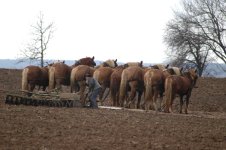I was cleaning up and moving some pictures around on the computer, and found these.
You are using an out of date browser. It may not display this or other websites correctly.
You should upgrade or use an alternative browser.
You should upgrade or use an alternative browser.
8 Horsepower
- Thread starter Hookblock
- Start date
- Views: 2686
/ 8 Horsepower
#1
carpenter383
Platinum Member
Neat pics!
JB4310
Super Member
Very cool, but that team has got to equate to more than 8 HP!! makes you wonder how we came up with that measure.
I like it, disc and fertilize at the same time.
JB.
I like it, disc and fertilize at the same time.
JB.
jinman
Rest in Peace
- Joined
- Feb 23, 2001
- Messages
- 20,387
- Location
- Texas - Wise County - Sunset
- Tractor
- NHTC45D, NH LB75B, Ford Jubilee
The last picture with the two kids running alongside is a postcard shot. Very nice! That looks like a beautiful team.
mike4038
Member
- Joined
- Nov 14, 2003
- Messages
- 34
- Location
- Texas
- Tractor
- kubota B7500 1948 Farmall A 1968 Cub Cadet 73
From Wikipedia, the free encyclopedia,Very cool, but that team has got to equate to more than 8 HP!! makes you wonder how we came up with that measure.
I like it, disc and fertilize at the same time.
JB.
The development of the steam engine provided a reason to equate the output of horses with the engines that could replace them. In 1702, Thomas Savery wrote in The Miner's Friend: "So that an engine which will raise as much water as two horses, working together at one time in such a work, can do, and for which there must be constantly kept ten or twelve horses for doing the same. Then I say, such an engine may be made large enough to do the work required in employing eight, ten, fifteen, or twenty horses to be constantly maintained and kept for doing such a work..." The term "horsepower" was coined later by James Watt to help market his improved steam engine. He had previously agreed to take royalties of one third of the savings in coal from the older Newcomen steam engines.[2] This royalty scheme did not work with customers who did not have existing steam engines but used horses instead. Watt determined that a horse could turn a mill wheel 144 times in an hour (or 2.4 times a minute). The wheel was 12 feet in radius, therefore the horse travelled 2.4 ラ 2π ラ 12 feet in one minute. Watt judged that the horse could pull with a force of 180 pounds (assuming that the measurements of mass were equivalent to measurements of force in pounds-force, which were not well-defined units at the time). So:
power = \frac{work}{time} = \frac{force \times distance}{time} = \frac{(180 \mbox{ lbf})(2.4 \times 2 \pi \times 12 \mbox{ ft})}{1\ \mbox{min}}=32,572 \frac{\mbox{ft} \cdot \mbox{lbf}}{\mbox{min}}.
This was rounded to an even 33,000 ftキlbf/min.[3]
Others recount that Watt determined that a pony could lift an average 220 pounds 100 feet (30 m) per minute over a four-hour working shift. Watt then judged a horse was 50% more powerful than a pony and thus arrived at the 33,000 ftキlbf/min figure.
Engineering in History recounts that John Smeaton initially estimated that a horse could produce 22,916-foot-pounds per minute. John Desaguliers increased that to 27,500-foot-pounds per minute. "Watt found by experiment in 1782 that a 'brewery horse' was able to produce 32,400-foot-pounds per minute". James Watt and Matthew Boulton standardized that figure at 33,000 the next year.[4]
Put into perspective, a healthy human can produce about 1.2 hp briefly (see Orders of magnitude (power)) and sustain about 0.1 hp indefinitely, and trained athletes can manage up to about 0.3 horsepower for a period of several hours.
Most observers familiar with horses and their capabilities estimate that Watt was either a bit optimistic or intended to under promise and over deliver; few horses can maintain that effort for long. Regardless, comparison to a horse proved to be an enduring marketing tool.
WayneB
Elite Member
Just curous if that was a local Amish team and pictures?
JB4310
Super Member
Most observers familiar with horses and their capabilities estimate that Watt was either a bit optimistic or intended to under promise and over deliver; few horses can maintain that effort for long. Regardless, comparison to a horse proved to be an enduring marketing tool.
I can't follow all those formulas, I was just comparing that team to my 8 HP wheel horse garden tractor, and the fact that it doesn't seem like a close comparison. Don't think I could pull that disc if it had wheels on pavement.
I figured must be Amish, Do they put teams together with more horses than that, that's the largest I've seen.
JB.
This was a local amish farmer. I sometimes grumble if my I match doesn't line on the first time, he has to get 8 horses lined up. The most I have ever seen on a team was 4 horses, he might be trying to show up the neighbors  . I knew about the hp formula, don't understand it, but like JB how do you compare this set up to a tractor? The field he was working was about 20 ac. It was just impressive to watch. The kids were picking rocks.
. I knew about the hp formula, don't understand it, but like JB how do you compare this set up to a tractor? The field he was working was about 20 ac. It was just impressive to watch. The kids were picking rocks.
ToadHill
Elite Member
- Joined
- Oct 18, 2005
- Messages
- 2,662
- Location
- Catt county New York
- Tractor
- Kioti DK35, Ford 8N, Oliver Cletrac
Ah, yes I remember those days when as kids we had actual jobs to do. No play time until your chores were done. Now if you did that in a non amish community they'd turn you in for child abuse.






